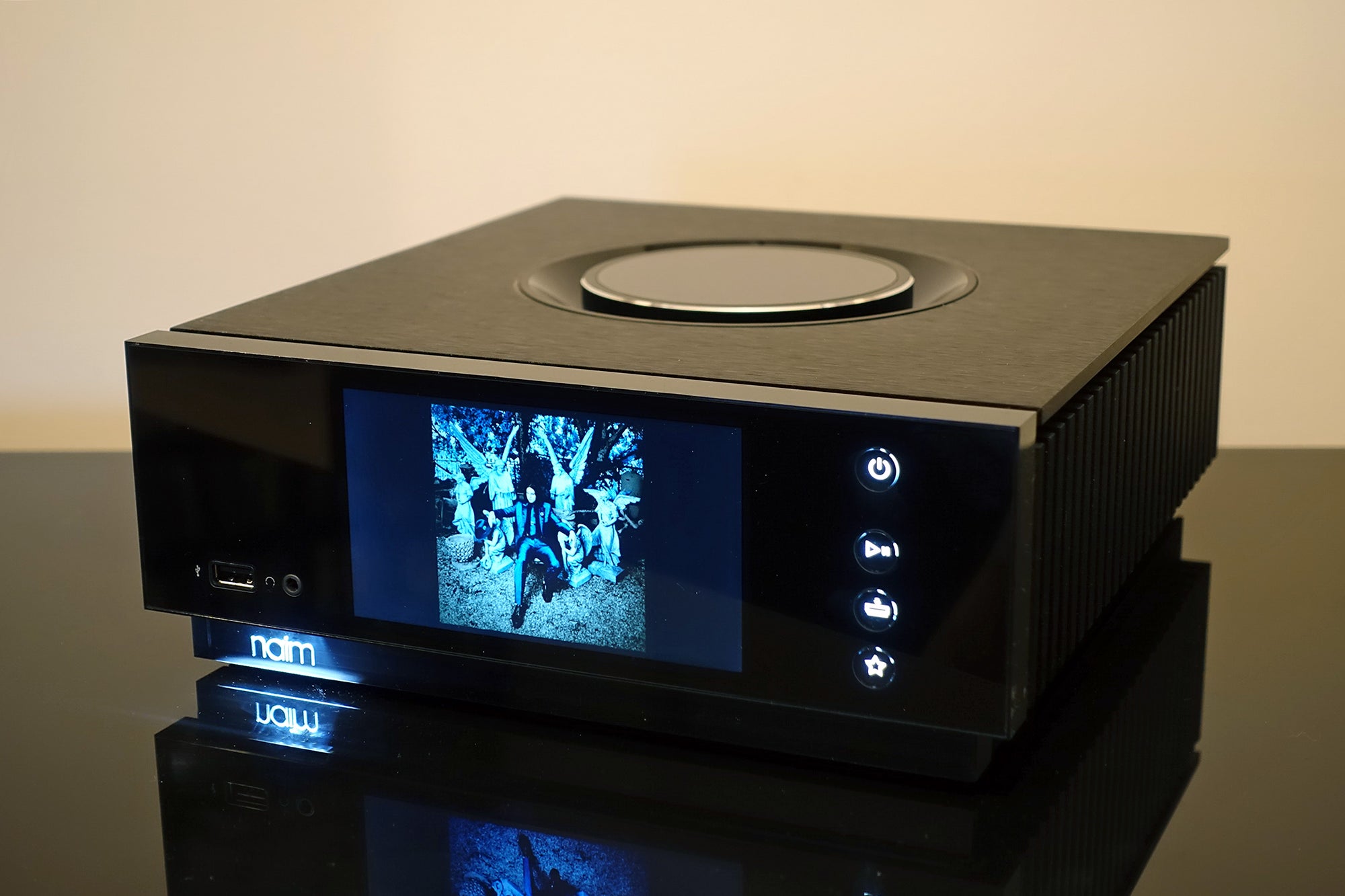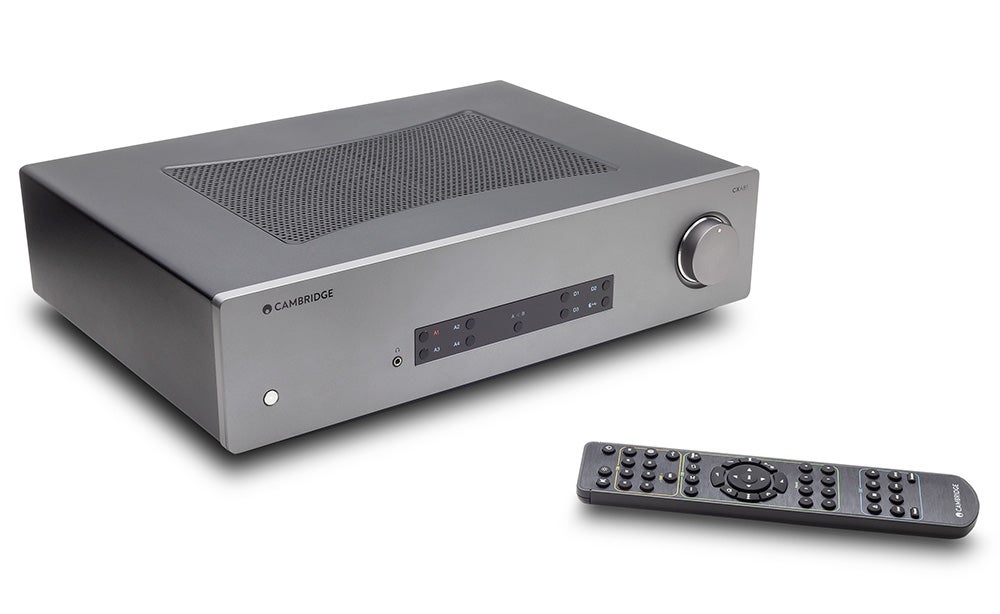Astell and Kern Aultima SR35 Review
Astell & Kern's entry-level player is a class act





Verdict
A portable music player that brings plenty of musical refinement to your music library, the Astell & Kern A&ultima SR35 is one of the best picks for the price.
Pros
- Brings refinement to music library
- Compact size
- Easy to use
- Wide file support
Cons
- Wi-Fi performance can be a little slow
- Battery life doesn’t feel too extensive
- Getting pricey for an entry level product
Key Features
- Two set-gainNormal and High Gain levels to match headphone impedance
- Battery lifeUp to 20 hours battery life
- MQACan full decode MQA audio streams
Introduction
Much like wired headphones, the portable music player was said to be on its knees, ushered out of the way by the popularity of smartphones. After all, who wants two devices in their pocket when one is focused on audio and the other can do that – and more.
There’s no doubt the existence of the smartphone has dented the appeal of the portable music player, but they’re still hanging around, and while they likely won’t enjoy the same level of mass appeal as MP3 players in their heyday, for a certain person, they are ideal.
If you’re a music fan, a portable music player is the best way to hear your music, and one of the most notable brands is Korean company Astell & Kern. They’ve been pumping out excellent portable music players for years, the latest in the more affordable A&norma line-up is the SR35.
Design
- Compact form
- 720p screen
- Angular design
The Astell & Kern A&norma SR35 is a portable music player that’s genuinely portable. Unlike the FiiO M11S, which does its best impression of a smartphone (but even bigger), the SR35 is dinky by comparison.

It’s the same size as previous iterations: 64mm wide, 108.3mm tall and 16.1mm deep. It is dwarfed by the size of modern smartphones and may solve the problem of having two devices on your person at the same time by being so compact.
Its proportions mean the screen takes a hit compared to its FiiO rivals at 3.6-inches with a resolution of 1280 x 720p. As is par for the course with Astell & Kern products, the screen is off-axis – slanted diagonally with the shape of the SR35 employing contoured lines. Most of the time I don’t even think about the angular screen.
The screen itself is bright and naturally colourful, the black UI provides contrast for albums to pop better.
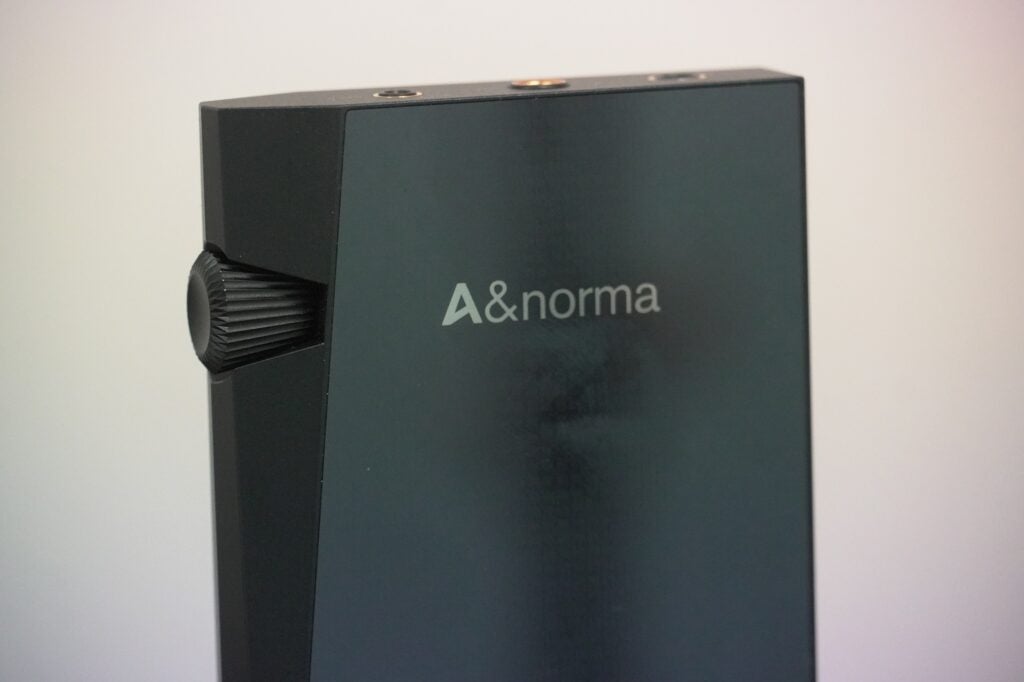
The colourway is charcoal grey, which looks lovely, and the chassis is aluminum which makes the A&norma SR35 feel light but still sturdy, backed up by an attractive glass finish on its rear. It looks terrific, though the glass back attracts smudges. While the chassis is cool to touch when off, the player can run warm during use.
Astell & Kern places the headphone outputs at the top, which I slightly prefer to the bottom. It makes it easier to take the player out without having to twist the screen (and start tangling the cables). You get an unbalanced 3.5mm, and two balanced outputs in 2.5mm and 4.4mm options. At the bottom is a USB-C input and microSD slot.
On the right-hand side is a satisfyingly clicky volume wheel, while on the left side are the buttons for turning the screen on and off/power and playback: pausing and skipping backwards and forwards. They’re spaced so close together that with my big digits, I’ve had to be more careful to avoid pressing the wrong button.
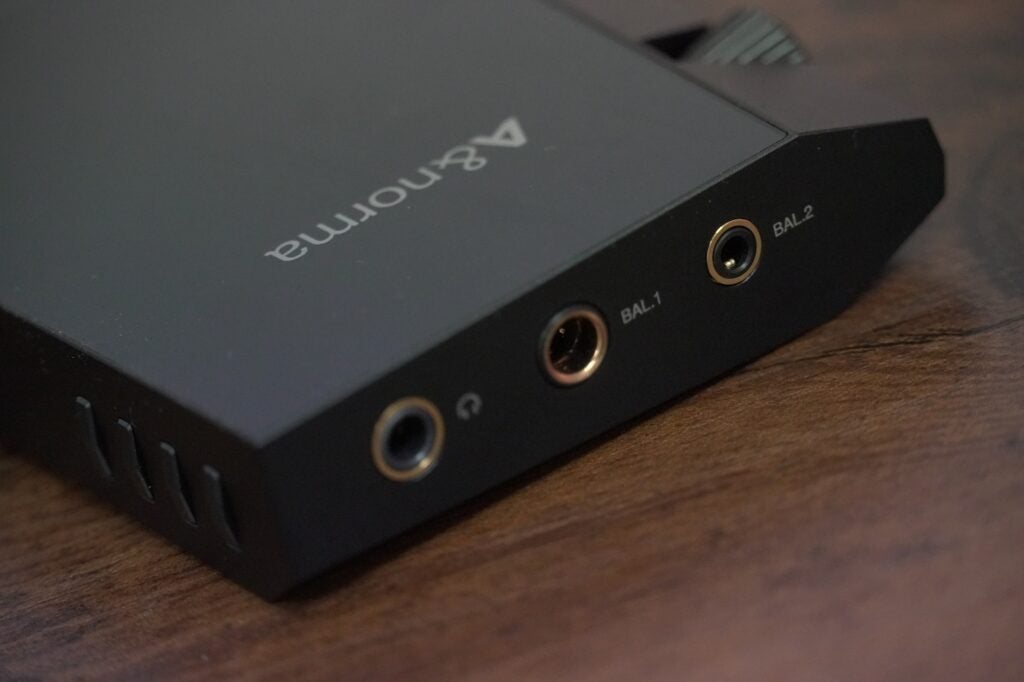
Features
- MQA decoding for Tidal Masters tracks
- Bluetooth and Wi-Fi connectivity
- Wide file support
I’ll start with the interface. It’s based on Android but specifically customised and labelled as the ‘Crimson’ themed UX/UI. It operates in a similar fashion to Android with a swipe down revealing notifications, wireless connectivity, EQ modes and a brightness slider for the screen. Swipe left or right and you’ll roll through the carousel of albums. It’s mostly speedy and fluid with no alarming lag in operation thanks to the quad-core processor onboard.
Unlike FiiO, Astell & Kern does not support the Google Play Store but offers a selection of apps to download in Spotify, Tidal, Qobuz, Apple Music, Deezer, and others I’ve not heard of before such as Moov and KKBox.

The A&norma SR35 can boot up reasonably quickly, but at times it can be slow with its Wi-Fi performance. There have been times when I’ve jumped into an app, started navigating the interface only to be told that I can’t stream audio because I’m not connected to the Wi-Fi, even though I am.
There’s a glut of features that includes AK File Drop which wirelessly transfers files to a PC, smartphone or FTP program on the same network. The BT Sink function connects to an external device over Bluetooth, like a smartphone connecting to a Bluetooth speaker. Bluetooth connectivity remains at v5.0, with aptX HD and LDAC compatibility for higher quality audio streams.

Storage is only 64GB internally, which speaks the A&norma’s entry-level status, but can be bumped up to a maximum of 1TB with a microSD card.
Battery is stated at 20 hours playing 16-bit FLAC files at volume level 50 through the unbalanced connection. Obviously, this can change at different volumes, screen brightness, and headphones, though my experience is that the SR35 can chomp through its battery quicker than expected. Charging back to full beans is 2.5 hours with no fast-charging listed as part of the spec.
Audio format support is extensive, close to if not matching Astell & Kern’s more expensive players. There is support for WAV, FLAC, WMA, MP3, OGG, APE, AAC, ALAC, AIFF, DFF, DSF formats, and for streaming it can decode MQA streams used by Tidal. PCM file support reaches up to 32-bit/384kHz, while native DSD playback is up to DSD256. There’s Roon Ready support for integration with other Roon compliant audio devices.
The SR35 also features a two-step gain control to match with headphones of varying impedance. For lower impedance rated headphones, the ‘Normal Gain’ setting can be selected; for more sensitive headphones there’s the option of the ‘High’ gain mode to produce a more sufficient output.
Sound Quality
- Brings sharpness, detail, and dynamism to music
- Retains the tone of partnered headphones
I had thought the Astell & Kern A&norma SR35 would work similarly to other A&K products, exerting its interpretation of audio on its partnered headphone, like the AK HC3 DAC. That’s not the case.
Yes, there is an effect that the A&norma has on headphones, but I don’t feel it significantly alters the headphone’s own sonic signature. It takes what’s there and it gives it more polish and refinement, and in doing so, the AK SR35 elevates the overall performance.
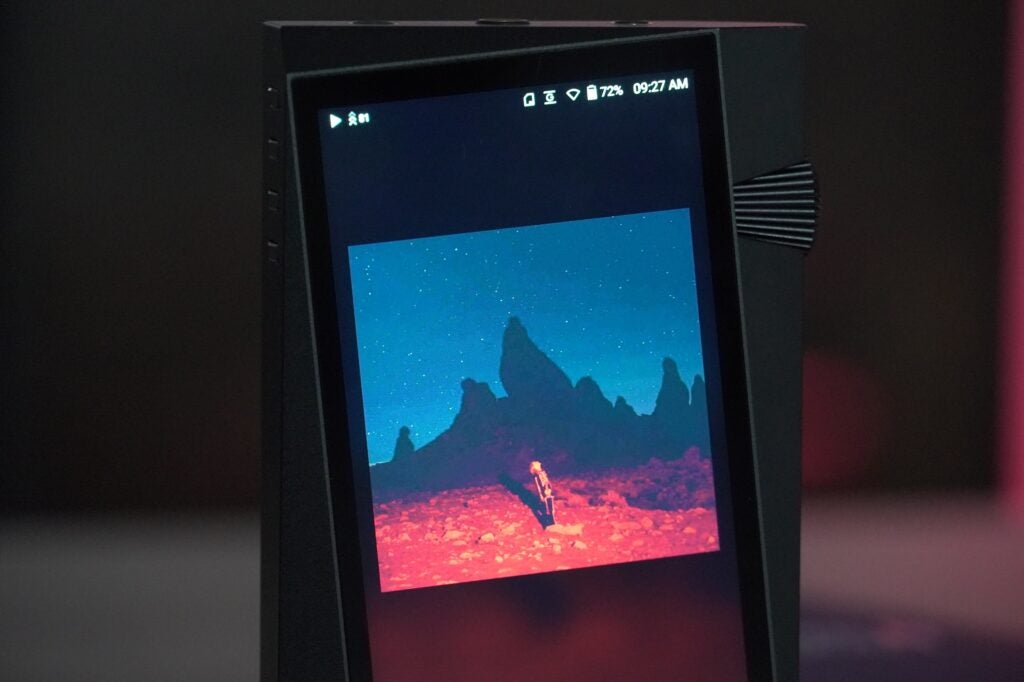
To describe the SR35’s tone is slightly tricky, as it depends on the headphone. I’ve used them with a Sivga Robin SV021, Campfire Andromeda Emerald Sea in-ear monitor, Sivga Luan, and Austrian Audio Hi-X65 open-backed headphones and, more or less, they’ve retained their own character.
What the A&norma SR35 imparts on headphones is a sharper sense of definition and higher levels of clarity. Compared to the similarly priced FiiO M15s, and using the Campfire Andromeda Emerald Sea IEM, a Hi-res track of The Beatles Long and Winding Road (Qobuz) fares much better on the Astell. It’s fettered with more detail and displays a more convincing sense of dynamism than the FiiO manages.
There’s not as great a focus on his voice, and the soundstage is described in smaller terms than the FiiO, but the SR35 teases out more resolution from the recording, high frequencies are sharper, better defined; the A&norma digs out more detail from everything whether its Paul McCartney’s voice or the instruments – I hear more insight with the SR35 than I do with the FiiO.

With Esperanza Spalding’s I Know You Know (Qobuz), the dynamic range once is better expressed on the A&norma SR35, the piano more detailed, sharper, and defined. The FiiO, by comparison, is not as focused.
With a play of David Bowie’s Modern Love on the Austrian Audio Hi-X65, and the SR35 communicates the energy and momentum of the track with confidence. Tonally the midrange is leaner and crisper, and bass is delivered with punch (but not overzealously). That contrasts with the FiiO’s smoother approach. Of the two, the Astell & Kern is the more exciting and assertive listen.

With the Sivga Luan and Ludwig Göransson’s Oppenheimer in flow, the SR35 doesn’t tread on the headphone’s lush, smooth presentation. There’s a nice weight to bass in American Prometheus, the reproduction of the violin is nicely sharp and textured, and there’s solid dynamic expression as the notes rise and fall. With Talking Heads’ Once In a Lifetime, it maintains the headphones’ smooth midrange performance, David Byrne’s unique vocal expression comes across naturally.
You could play with the EQ – the headphones offer a ‘Normal’ EQ – but I find the soundstage contracts, and while there’s the option of going into greater detail by altering the gain or Q value of each frequency, unless you enjoy that sort of thing, I find it’s better to leave as is.

Latest deals
Should you buy it?
For the refinement it offers to music
The A&ultima SR35 doesn’t go about altering the sonic signature of your headphones. Instead, it refines with extra lashings of detail, sharpness and dynamism for an even better sound.
It’s getting more expensive
The performance is excellent, but with each new iteration of the A&ultima series, it’s becoming more expensive. £800 / $800 for an entry level product raises a few eyebrows.
Final Thoughts
Astell & Kern describes the A&norma SR35 as its entry-level product and that seems a good enough description. It’s not less complex than its more expensive cousins, but the smaller form factor and less expensive price works in its favour.
Whether your headphone sounds crisp or warm, the SR35 won’t alter it unrecognizably but refine it with more definition, sharpness, and dynamic expression.
It’s still expensive, the price slowly increasing from the £649 of the SR25 this site reviewed in 2020, and up from the SR25 MkII (£699 / $749) or the FiiO M11S (£489). That might be an impediment to some, but for others for whom the price is not as insurmountable, the A&norma is another stylish, feature-packed, and insightful-sounding portable music player from Astell & Kern.
How we test
We test every portable music player we review thoroughly over an extended period of time. We use industry standard tests to compare features properly. We’ll always tell you what we find. We never, ever, accept money to review a product.
Find out more about how we test in our ethics policy.
Tested across several weeks
Tested with real world use
Tested with a range of headphones
FAQs
It’s not all about wired headphones with this portable music player. You can connect over a Bluetooth connection, and you’ll get the best audio quality with headphones that support aptX HD or LDAC.



